
The Development of the modern Russian Army Camouflage Pattern
The Development of the modern Russian Army Camouflage Pattern
This blog article is about Russian Army clothing and there camouflage pattern since World War 1 to date. The following are the uniform that the Russian nation used to keep as a representation of the state power and unity. Check them out! #russianarmy #camouflage
The Old Russian camouflage-patterns
Russia is the largest country in the whole world, covering the better part of the land of Europe and Northern Asia. The Russian Army has been experimenting with the concept of camouflage since 1937. Their very first uniform was a white over-sized suit that the troops wore during winter. The first Soviet tactical gear pattern was introduced in 1938. During the Russian transition period, the armed forces of Russia continued using the camouflage-designs and patterns used in the Union of Soviet Socialists Republic (USSR). The oldest pattern embraced and widely used by the Russian Special Forces today for Engineer & Cossack units, and reservists of the Country’s Army was the Sunshine Rays-KLMK (solnechnye zaychiki) uniform.

This pattern is currently known as Birch (berezhka) or Silver leaf (serebryanyi list).
The wartime patterns were produced in large numbers and were put in use by the Soviet Armed forces for centuries. Russia also gave out large stocks of some of their Military uniforms to other socialist nations such as Romania and Albania.
The first mass production of the Soviet pattern was the MKK (makirovochnyi kamuflirovannyi kostium).
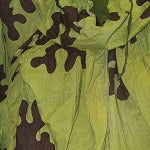
This design included a light green or khaki background with large Amoeba shaped reddish-brown patterns. The colors of these uniforms varied with the factory producing them. These colors variations were used for different climate types or according to particular seasons. These uniforms served longer especially by the reservists and the Cadets. This design was commonly known as the Soviet “Amoeba” pattern.
The Summer Camouflage
A different camouflage-design was introduced to the Russian Armed forces uniform in 1941. This one included a khaki background with dark green leaves printed on it. This pattern is known as “summer-camouflage”. This pattern was produced in two-color variations including green and grey-brown for use during different seasons. Large stocks of summer-camouflage were given to Romania where they were used as the main camouflage-uniform until the 1990s. The summer camouflage-design is also known as the “leaf” pattern, and the reason is just obvious.
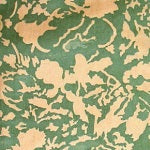
|
 |
The 3 colors disruptive pattern
Later in the war in the year 1944, TTsMKK uniform was introduced. The design was printed in three colors disruptive-camouflage, a pattern said to have been developed by Soviets to confuse the German night vision devices that appeared in 1944. These patterns included an overlapping foliage green and dark green on a yellow-tan background. This design was to be embraced by many soviet designs in the years to come. This tactical gear was used up to the 1950s and was later exported to Albania where their Elite units used it up to the 1990s. Similar variations were also worn by the Russian Armed forces in the 2000s.

Approaching the end of the 2nd world war, another camouflage-design emerged that seems to have been used for a short time. It included the features from TTsMKK design with amoeba shape prints on top. This design documented its use from 1945 to 1950 with no evident documentation beyond there. Later on, Modern versions of this design were witnessed from the Russian-Army 2000s camouflage-designs.
Another design that left very little information behind was the falling leaf camouflage (listopad kamuflyazh). This version seems to have short-lived and produced in not so large quantities. The design appeared during the post-war period.
Reversible camouflage-pattern
This design was introduced in 1948 featuring tan leaf prints on a light green field. The patterns also included on the opposite side intended to confuse the early night vision equipment. This pattern can be found in KLMK style coveralls even though there is no enough evidence to show that it was a trial pattern or more than that. To distinguish this pattern from the Soviet leaf pattern, it was given the name Type 11 leaf pattern.
Come the 1950s, soviet camouflage-design made a little progress. In the following decade, new styles of uniforms were introduced to the Russian-Army. Later on, a pattern KLMK “sunshine rays” was produced from the 1980s to 1990s lacked the reversible grid pattern of the opposite sides.
Splatter/Splotch design
This design emerged in the 1960s featuring large irregular grey blotches on a green background. The other side was printed with a similar pattern to that of the 1948 leaf print. This uniform was worn as a one-piece lightweight coverall with facemasks referred to as KLMK ( kamuflirovannyi letnyi maskirovochnyi kombinezon) This pattern then started to gradually disappear in the 1970s
 |
 |
“Sunshine rays” ( solnechnye zaychiki) design is a uniform introduced at the beginning of 1968 featuring a revisitation of the “stair-step” design (original Soviet). It was also released as a reversible KLMK having the same grid patterns on the opposite sides. It included jagged tan shapes on a green grass background that was later printed on a two-piece camouflage-uniform. The uniform also included accessories such as sun hat, berets, and field caps. The stair-step design, which is also referred to as “sun bunnies” pattern, continued to be used by soviet and ex-soviet republics incorporating some slight changes up to the present time. There are a few of these variations documented. Some of them feature minor shades of dark or light green, blurred printing, or more of similar patterns matching on the opposite sides.
TTsKO 3 camouflage-pattern
The three-color camouflage-uniform remained in service in some units of the Russian Military service in 1981. This pattern was earlier known as Butan (butane), which was the name of the camouflage-development program. The uniform was initially produced as six-pocket combat for some units; it, later on, entered into the production of winter uniforms. This pattern is the most varied of all the soviet designed camouflage-patterns even though its use by the ex-soviet republic is coming to an end. The primary colors include the green and brown variants while the sub-variants are green/blue, pink, tan, green/red, and oxblood.
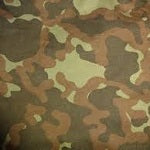
There is a TTsKO version that was produced in Russia and found in Africa. It includes different versions of the earlier Russian-Army pattern designs as well as the tan-red color combinations similar to the Moldova patterns.
There existed another bi-color TTsKO pattern that never lived too long that consists of dark green shapes on a khaki background. This pattern must have been produced in small quantities from 1990 to 1991 even though it seems to have been used all through the post-soviet era.
Circa – The floral series
The floral series of patterns were introduced in 1998 that was referred to as “Watermelon” (Arbuz). This camouflage-pattern appears like the ancient 3-TsV pattern modification, where drawings have been slightly enlarged and aligned horizontally. In the real sense, the design is not a copied version, and several color combinations have been done. Before the pixelated camouflage-pattern was introduced, watermelon was the standard general camouflage-pattern for Russian armed forces, conventional units, and the ministry of internal affairs.
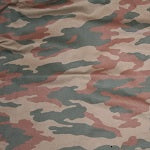
Since the 2000s, the old soviet sunray has been used less by the Russian Army in special operations role and reconnaissance. The pattern was later termed as a birch tree (Berezhka) and incorporated the original design. Various colors have been produced by different companies and brought on board by commercial suppliers.
The SS summer pattern
This pattern was largely influenced by the German Oakleaf pattern. It features dark brown, loam, and sandy yellow patterns on a green background and the same pattern on the other side. There is an autumn version that features loam, black, ochre, dark brown, and moss green shapes on a sandy field with the same grid pattern on the opposite side. These two patterns are popular with Russian troops operating in the MDV and VSR as well as the pattern’s initial users, the FSB
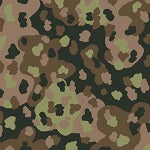 |
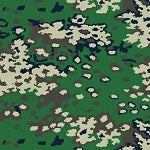 |
Pixelated camouflage-design
This camouflage-pattern was introduced in 2008 with the intention of replacing the VSR and flora patterns. This pattern is known as EMR or the Unified camouflage-coloration, meaning that it is the most common camouflage-pattern in Russia.

It consists of tiny pixels of black, foliage green, reddish-brown, and on a pale green background. Another pixelated version incorporated light brown/tan was used since the year 2013.
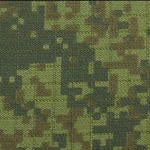
Fractal camouflage-pattern
This pattern was tested in 2014 and is still being used by the current Russian-Army. It is common on some uniforms as well as military equipment. It was initially issued to the reconciliation center that was created in 2016 with the aim of supporting the Russian military in Syria. The colors in the pattern include khaki, pinkish sand, tan, reddish-brown, and medium brown shades. The camouflage-pattern has been in service since 2017 with the Russian units.
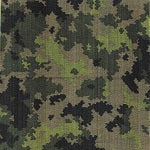
Russian forces are now having a camouflage-design to help them in operations under heavy snow conditions. The design was introduced in 2019 and incorporated Berezkha drawing with some mesh-like appearance.
Russian Camou-BDU on amazon:
